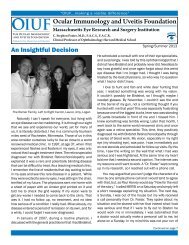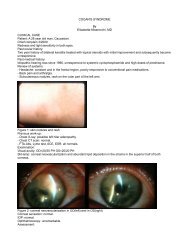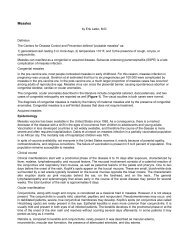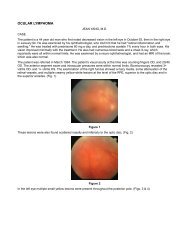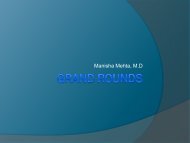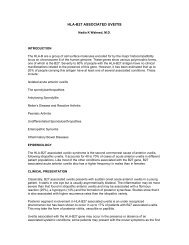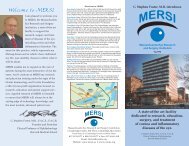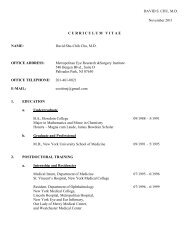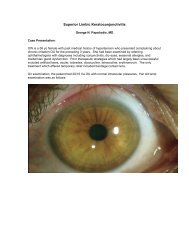serpiginous_chroiditis.pdf (401.22 KB) - Ocular Immunology and ...
serpiginous_chroiditis.pdf (401.22 KB) - Ocular Immunology and ...
serpiginous_chroiditis.pdf (401.22 KB) - Ocular Immunology and ...
Create successful ePaper yourself
Turn your PDF publications into a flip-book with our unique Google optimized e-Paper software.
Serpiginous ChoroiditisAndrea P. Da Mata, M.D.ABSTRACTBackground: Serpiginous choroiditis also called geographic helicoid peripapillary choroidopathyis a rare, idiopathic inflammatory disease affecting the inner choroid <strong>and</strong> retinal pigmentepithelium. Typically <strong>serpiginous</strong> choroiditis occurs bilaterally <strong>and</strong> is relentlessly progressive.Though long st<strong>and</strong>ing remissions can be achieved through aggressive immuno-modulation,patients not receiving such therapy often suffer through multiple exacerbations <strong>and</strong> are often leftwith macular scarring, <strong>and</strong> significant visual loss.Materials <strong>and</strong> Methods: A 28 year-old man presented with 2 weeks of blurry vision in his righteye, <strong>and</strong> long st<strong>and</strong>ing decreased vision in his left eye. He noted worsening of his vision ODdespite prior treatment with oral <strong>and</strong> topical corticosteroids.Results: A diagnosis of <strong>serpiginous</strong> choroiditis was made. The patient was treated with tripleagent immunosuppressive therapy <strong>and</strong> enjoyed dramatic improvement in his visual acuity in botheyes. Over the past 3 years his disease has remained quiescent while the immunosuppression isbeing slowly weaned.Conclusion: Serpiginous choroiditis is a rare idiopathic inflammatory disease. The diagnosis of<strong>serpiginous</strong> choroiditis is made based upon its clinical manifestations. Treatment of <strong>serpiginous</strong>choroiditis requires aggressive immunosuppression <strong>and</strong> careful, long-term observation.Case ReportA 28 year-old Italian man from Milano was referred with a 2 week history of blurred vision in hisright eye that was getting progressively worse despite treatment with systemic <strong>and</strong> topicalcorticosteroids. His past ocular history was significant for idiopathic macular chorioretinitis in theleft eye 8 years earlier. He noted a recent flu like illness. He denied any family history of oculardisease.
Fig. 1 _________________ Fig. 2Examination demonstrated a visual acuity of 20/30 OD, <strong>and</strong> 20/200 OS. Anterior segments werequiet OU. Intraocular pressures were 13 mm Hg in both eyes. The funduscopic exam of the righteye revealed a parafoveal, subretinal, elevated, grayish-yellow lesion <strong>and</strong> a gray subretinal lesionin the infero-nasal macula (Figure 1). Funduscopic exam of the left eye demonstrated a largegeographic pigmented chorioretinal scar throughout the macula (Figure 2).Fluorescein angiography showed early hypofluorescence followed by late leakage in the activeareas of the right eye (Figures 3 & 4). The old lesion in the left eye demonstrated blockage offluorescence corresponding to the areas of RPE hypertrophy with staining along the edges(Figure 5 ).
Fig. 3_________________Fig. 4
Fig. 5An extensive work up was undertaken including: CBC, ESR, ACE, RPR, FTA/ABS, HIV, HepatitisB, Hepatitis C; HSV, CMV, toxoplasma, <strong>and</strong> Lyme titer, as well as a urinalysis <strong>and</strong> chest X ray,<strong>and</strong> all of these tests were normal. He had a positive hepatitis A IgG <strong>and</strong> herpes zoster virus IgGwhich were believed to be unrelated to his current problem.Based on the clinical presentation, fluorescein angiography, <strong>and</strong> negative work up for systemic orinfectious disease a diagnosis of <strong>serpiginous</strong> choroiditis was made. Treatment with cyclosporin200 mg po daily <strong>and</strong> prednisone 60 mg po daily was initiated.Fig. 6
The patient returned 1 week later complaining of worsening of his vision. His visual acuity was20/200 OD, 20/300 OS. The anterior segments remained normal, but the fundus of the right eyeshowed increased subretinal fluid <strong>and</strong> continued active choroiditis (Figure 6). Facing thissituation we increased the cyclosporin to 300 mg daily, <strong>and</strong> added azathioprine 150 mg daily. Theprednisone was continued at 60 mg daily.Fig. 7One week later (2 weeks after the initial presentation) he returned with a visual acuity of 20/50OD, 20/70 OS. Dilated funduscopic exam of the right eye showed a healing lesion with increasingpigmentation <strong>and</strong> a salt <strong>and</strong> pepper appearance (Figure 7). Funduscopic exam of the left eyeappeared unchanged despite the significant improvement in vision. At this point the cyclosporin<strong>and</strong> azathioprine were continued, <strong>and</strong> the prednisone was reduced to 40 mg daily.4 weeks after the initial presentation he came back complaining of a scotoma in his right eye. Hisvisual acuity was 20/30 OD, 20/70 OS <strong>and</strong> a pigmented glistening scar could be seen on fundusexamination OD (Figure 8). The cyclosporin was increased to 400 mg daily approaching the goalof 500 mg daily.
Fig. 8 _________________ Fig. 96 weeks after the initial visit he returned with a visual acuity of 20/16 OD, 20/63 OS. The fundusexam showed a geographic inactive pigmented chorioretinal scar (Figure 9). The cyclosporin wasincreased to 500 mg daily, <strong>and</strong> azathioprine was increased to 200 mg daily, prednisone wascontinued at 40 mg daily.The patient returned to Italy with this maintenance treatment. During the past 3 years hisimmunosuppressive therapy has been tapered to 150 mg daily of cyclosporin, 150 mg daily ofazathioprine, <strong>and</strong> 10 mg of prednisone every other day. He is monitored with periodic bloodpressure measurements, <strong>and</strong> labs including: CBC, BUN, creatinine. He is being carefully followedin collaboration with his local ophthalmologist by serial photos with FA/ICG. His eyes are doingextremely well. He currently enjoys visual acuities of 20/16 OD <strong>and</strong> 20/60 OS. There has been nosign of reactivation to date.
SERPIGINOUS CHOROIDITISSerpiginous choroiditis also called geographic helicoid peripapillary choroidopathy is a rareidiopathic inflammatory disease affecting the inner choroid <strong>and</strong> retinal pigment epithelium.EpidemiologySerpiginous choroiditis is slightly more common in men. The age of the onset usually ranges from30 to 70 years, although it may occur in younger patients. There is no proven racial predilection,no familial propensity <strong>and</strong> no known associations with drugs, trauma or allergy. The conditionappears to have no related systemic manifestations. Erkkila <strong>and</strong> colleagues reported in a Finnishstudy an association of <strong>serpiginous</strong> choroiditis with a greater prevalence of HLA B7. King <strong>and</strong>associates described an elevated factor VIII-vWF in 8 patients, <strong>and</strong> Broekhuyse <strong>and</strong> coworkersdemonstrated increased immune responsiveness to retinal S antigen (arrestin) in patients with<strong>serpiginous</strong> choroiditis.PresentationPatients with <strong>serpiginous</strong> choroiditis can present variable vision that ranges from normal to h<strong>and</strong>movements. Visual field examination typically will reveal small central or paracentral scotomas.The anterior segment is usually normal, however, anterior uveitis <strong>and</strong> vitritis may occur. The opticnerve is not affected. The electroculogram <strong>and</strong> electroretinogram tend to be unchanged, althoughextensive disease does cause abnormal results.HistopathologyThe histopathology of <strong>serpiginous</strong> choroiditis is not extensively documented. Wu et al. reportedthe pathologic findings in a patient with the clinical features of <strong>serpiginous</strong> choroiditis. They noteddiffuse <strong>and</strong> focal lymphocytic infiltrates in the choroid. The infiltrate was greatest at the margins ofthe lesions. Atrophy of the overlying RPE <strong>and</strong> photoreceptors was seen. There was a variabledegree of RPE hyperplasia. Breaks in Bruch’s membrane were also seen, with fibroglial tissueproliferating through.Chorioretinal FindingsThe typical lesion is discoid or geographic in shape often with finger-like projections. Lesionsgenerally begin in the peripapillary area, but the macula, regrettably, may be the initial site ofinvolvement. Acute lesions appear grayish-yellow with distinct boarders. As the lesions heal thereis chorioretinal scarring with variable RPE hypertrophy, <strong>and</strong> atrophy, as well as fibrosis. Choroidalneovascularization occurs in about 25% of the patients, <strong>and</strong> may lead to subretinal fluid <strong>and</strong>hemorrhage. Other findings may include retinal vasculitis, retinal detachment, RPE detachment,branch vein or combined branch vein-artery occlusion <strong>and</strong> neovascularization of the optic disc orelsewhere.Clinical CourseSerpiginous choroiditis is a chronic, bilateral, asymmetric, <strong>and</strong> progressive disease. Acute lesionslast weeks to months then resolve with scarring <strong>and</strong> atrophy. Recurrence is the rule. The newlesions spread centrifugally contiguous to previous scars. Untreated, the prognosis is generallypoor, though extent of visual loss is often unpredictable.Diagnosis
The diagnosis of <strong>serpiginous</strong> choroiditis is based on clinical findings. The fluorescein angiographyis quite helpful. During the early phases the acute lesions are hypofluorescent due to blockage byedematous RPE <strong>and</strong> choroidal non-perfusion. The late phase of the angiogram demonstratesleakage <strong>and</strong> staining in the active areas. Old chorioretinal scars have a mottled appearancecaused by pigment clumping <strong>and</strong> atrophy, with late staining on fluorescein angiography.Fig. 10Indocyanine Green angiography is useful for identification <strong>and</strong> staging of new active lesions. Thearea of choroidal nonperfusion seen by ICG during the acute stage is generally larger than thecorresponding clinically observed retinal lesions. (Figure 10) The ICG is also useful in detectingsubclinical or persistent choroidal nonperfusion even when the signs of retinal activity havedisappeared.DifferentialDiagnosis:The most important condition to consider in the differential diagnosis of <strong>serpiginous</strong> choroiditis isacute posterior multifocal placoid pigment epitheliopathy (APMPPE). APMPPE lesions affect thechoroid <strong>and</strong> RPE, resulting in a fundus appearance <strong>and</strong> fluorescein angiographic pattern that maybe indistinguishable from <strong>serpiginous</strong> choroiditis. However there are several clinicalcharacteristics of APMPPE that allow one to differentiate it from <strong>serpiginous</strong> choroiditis. APMPPEpatients are generally younger with simultaneous bilateral involvement. The lesions heal in 7 to14 days <strong>and</strong> recurrences are rare. Residual scarring is generally limited to minimal choroidalatrophy, <strong>and</strong> the visual outcome in APMPPE tends to be much better than <strong>serpiginous</strong> choroiditis.Patients with APMPPE also often note a preceding viral illness.Other diseases that should be included in the differential diagnosis are toxoplasmosis, TB,syphilis, sympathetic ophthalmia, sarcoidosis, multifocal choroiditis, histoplasmosis, ARMD,
posterior scleritis, angioid streaks, choroidal tumors or any condition that causes either choroidalischemia or peripapillary subretinal neovascularization with scarring.TREATMENTSerpiginous choroiditis has tended to be progressive despite corticosteroid therapy. Yet, oral ortrans-septal corticosteroid has been the st<strong>and</strong>ard therapy for active disease. Steroid sparingtherapy was first suggested by Hooper <strong>and</strong> Kaplan, with combination azathioprine, cyclosporine<strong>and</strong> prednisone. Many experienced observers, including our service, believe that this tripletherapy or other immunosuppressive regimen (e.g. cyclophosphamide) may shorten the durationof the acute lesions <strong>and</strong> prevent recurrences.CNVM may be treated with laser photocoagulation for extrafoveal <strong>and</strong> juxtafoveal lesions.Subfoveal CNVM lesions have a poor prognosis, but experimental therapies such asphotodynamic therapy or proton beam irradiation may prove helpful in the future.Follow UpPatients must be followed carefully. A prolonged course of immunosuppression is given with avery slow taper to avoid recurrence. Amsler grid is very useful to monitor the course <strong>and</strong> activityof the disease, because the scotomas correspond with the choroidal lesions. Serial photos withFA/ ICG are also helpful in monitoring disease activity.References:Bock C, Jampol LM: Serpiginous Choroiditis In Albert DM, <strong>and</strong> Jakobiec FA, (ed): Principles <strong>and</strong>Practice of Ophthalmology, WB Saunders Philadelphia 1994, pp 517-523.Broekhuyse RM, Van Herck M, Pinckers AJLG, et al: Immune Responsiveness to Retinal S-Antigen <strong>and</strong> Opsin in Serpiginous Choroiditis <strong>and</strong> Other Retinal Diseases. Doc Ophthalmol .1988; 69:83-93Erkkila H, Laatikainen L, Jokinen E: Immunological Studies on Serpiginous Choroiditis. Graefe’sArch Clin Exp Ophthalmol. 1982; 219:131-134Giovannini A, Mariotti C, Ripa E, et al: Indocyanine Green Angiographic Findings in SerpiginousChoroidopathy. Br J Ophthalmol. 1996; 80:536-540Giovannini A, Ripa E, Scassellati-Sforzolini B, et al: Indocyanine Green Angiography inSerpiginous Choroidopathy. Eur J Ophthalmol. 1996; 3:299-306Hardy RA, Schatz H: Macular Geographic Helicoid Choroidopathy. Arch Ophthalmol. 1987;105:1237-1242Hooper PL, Kaplan HJ: Triple Agent Immunosuppression in Geographic Helicoid Choroidopathy.Ophthalmology. 1991; 98:944-952Jampol LM, Orth D, Daily MJ, Rabb MF: Subretinal Neovascularization with(Geographic)Serpiginous Choroiditis. Am J Ophthalmol1979; 88:683
King DG, Grizzard WS, Sever RJ, Espinosa L: Serpiginous Choroidopathy Associated withElevated Factor VIII-von Willebr<strong>and</strong> Factor Antigen. Retina 1990; 10:97.Mansour AM, Jampol LM, Packo KH, Hirsomalos NF: Macular Serpiginous Choroiditis. Retina.1988; 8:125-131.Schatz H, McDonald HR, Johnson RN: Geographic Helicoid Peripapillary Choroidopathy(Serpiginous Choroiditis) In Ryan SJ, (ed): Retina 2 nd Edition, Mosby St. Louis 1994, pp1721-1728Wu JS, Lewis H, Fine SL, et al: Clinicopathologic Findings in a Patient with SerpiginousChoroiditis <strong>and</strong> treated Choroidal Neovascularization. Retina. 1989; 9:292Review Questions for Serpiginous ChoroiditisAndrea P. Da Mata, M.D.1. Serpiginous choroiditis presents with all of the following EXCEPT:a. little to moderate vitritisb. blurred visionc. optic neuritisd. central or paracentral scotomas2. Serpiginous choroiditis:a. is bilateral <strong>and</strong> symmetricb. is more common in whitesc. is more common in the first <strong>and</strong> second decades of lifed. may recur after several months to years3. The chorioretinal lesions:a. usually start in the maculab. frequently develop a macular star with subretinal edemac. spread outward in a contiguous patternd. have telangiectatic vessels <strong>and</strong> intraretinal hemorrhages around the lesions4. Which of the following diseases may be considered in the <strong>serpiginous</strong> choroiditis differentialdiagnosis:a. Sarcoidosisb. APMPPEc. Toxoplasmosisd. Angioid streakse. All of the above5. Serpiginous choroiditis exhibits:a. Non Mendelian inheritanceb. Autosomal recessive inheritancec. No genetic propensity
d. X-linked recessive inheritance6. Wu <strong>and</strong> colleagues reported the clinicopathologic findings of <strong>serpiginous</strong> choroiditis. All of thefollowing are true EXCEPT:a. They noted diffuse <strong>and</strong> focal lymphocytic infiltrates in the choroid.b. Atrophy of the overlying RPE <strong>and</strong> photoreceptors was seen.c. There was a variable degree of RPE hyperplasia.d. Bruch’s membrane remained free of breaks.7. All of the following are true statements about <strong>serpiginous</strong> choroiditis EXCEPT:a. Amsler grid is very helpful to monitor the course <strong>and</strong> activity of the disease .b. The patients must be followed carefully.c. Visual prognosis has generally been poor.d. FA <strong>and</strong> ICG have no use for diagnosis or follow up.8. Immunosuppressive therapy:a. stops the progression immediately.b. should never be used.c. has been reported, in uncontrolled series, to be superior to steroid therapy for treatmentof <strong>serpiginous</strong> choroiditis.d. should be used no longer than 6 months.9. All of the following are complications of <strong>serpiginous</strong> choroiditis EXCEPTa. retinal vasculitisb. cataractc. CNVMd. retinal detachment10. The clinical course of <strong>serpiginous</strong> choroiditis is typically:a. chronic <strong>and</strong> progressiveb. a single acute episodec. benign with no permanent scarringd. self-limitedAnswers:1.c 6.d2.d 7.d3.c 8.c4.e 9.b5.c 10.a



